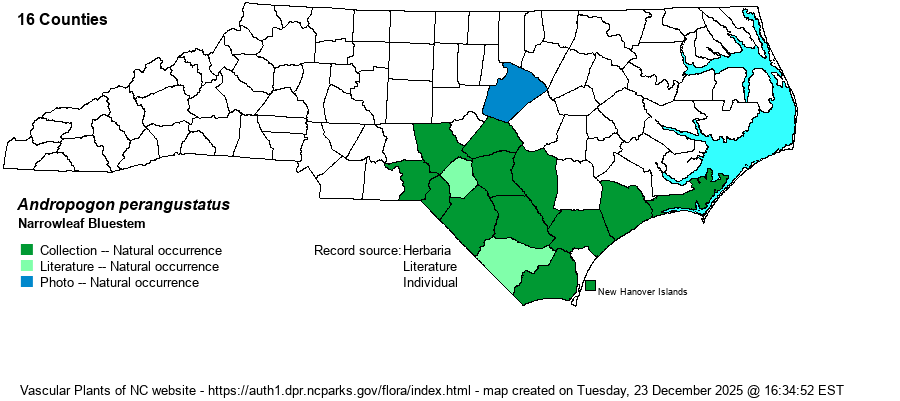| Author | Nash | |
| Distribution | Sandhills and the southern Coastal Plain -- north in NC to Carteret and Wake counties, though there are several records for southeastern VA. It could well be present in the northern half of the NC Coastal Plain.
Coastal Plain, southeastern VA to central FL and eastern TX. | |
| Abundance | Uncommon to infrequent; though widely distributed in NC, not numerous, and it is a Watch List species. | |
| Habitat | Wet pitcher-plant seepages, blackwater streamhead ecotones, clay-based Carolina bays, natural depression wetlands, wet powerlines, and wet margin of a granitic flatrock (Wake Co. in 2025). | |
| Phenology | Flowering and fruiting August-October. | |
| Identification | This is a very slender-leaved and short bluestem, producing tussock-like clumps. The elongate stem sheaths are like A. gyrans, but are narrower and hide less of the racemes; the racemes are well separated (vs. close together or closely spaced). Also, note the wetland habitat, as A. gyrans usually grows in upland/dry habitats.
| |
| Taxonomic Comments | In many texts treated as A. gyrans var. stenophyllus.
While the genus Andropogon is quite easy to recognize in the field, ID of species is not so easy and there are no shortcuts. Readers are strongly advised to read the introductory paragraphs in Weakley (2018) and to use his key. Once one has successfully keyed out several species, or compared collections with verified specimens, one can learn to recognize them in the field. | |
| Other Common Name(s) | None | |
| State Rank | S2S3 | |
| Global Rank | G5T4 [G4] | |
| State Status | W1 | |
| US Status | | |
| USACE-agcp | | |
| USACE-emp | | |

